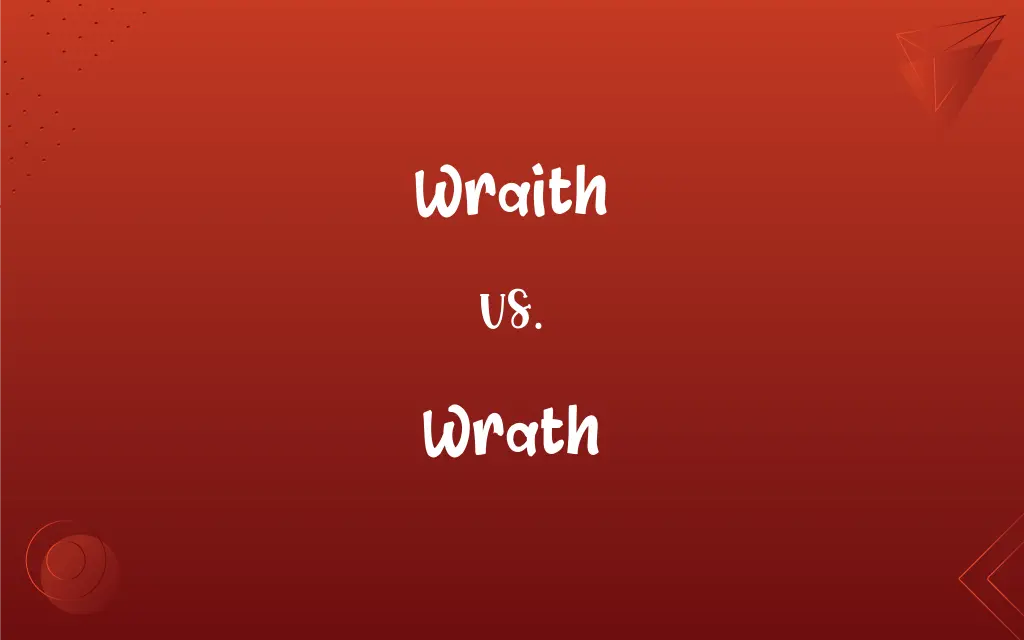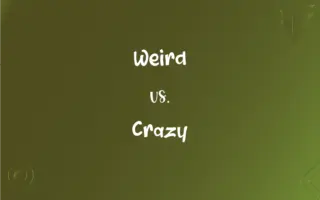Wraith vs. Wrath: What's the Difference?
By Janet White || Updated on May 20, 2024
A wraith is a ghost or spirit, often seen before death, while wrath is intense anger or rage. One pertains to supernatural beings, and the other to a strong emotional state.

Key Differences
A wraith is typically described as a ghostly apparition, often appearing just before or after someone's death. It embodies the concept of a spectral figure, representing the ethereal and mysterious aspects of the afterlife. In folklore, wraiths are often harbingers of doom or symbols of impending death. Wrath, on the other hand, refers to intense anger or rage. It is a powerful emotional state characterized by feelings of fury and vengeance. Wrath is often associated with a desire for retribution and can lead to destructive actions. While a wraith is a supernatural entity, wrath is an intense human emotion.
The term wraith has origins in Scottish folklore, where it was used to describe a ghost or spirit. Wraiths are often depicted as shadowy, indistinct figures, haunting places or people. This spectral nature sets wraiths apart from other types of ghosts or spirits. Wrath is derived from Old English and Old Norse roots, and it represents a strong, often uncontrollable, emotional response. It is commonly associated with stories of divine punishment or epic tales of revenge. Wrath is a key theme in many literary and religious texts, illustrating the consequences of unchecked anger.
While wraiths are otherworldly and intangible, wrath is deeply rooted in human experience and psychology. The two terms, despite their similar sounds, occupy vastly different realms of meaning. Wraiths evoke the mysterious and eerie, while wrath deals with the explosive and passionate aspects of human emotion.
Wraiths often appear in ghost stories and horror fiction, embodying fears of the unknown and death. In contrast, wrath is frequently explored in drama and tragedy, highlighting the destructive potential of human anger. Both terms, though distinct, offer rich material for exploring different aspects of fear and intensity.
Comparison Chart
Definition
A ghost or spirit, often seen before death
Intense anger or rage
ADVERTISEMENT
Origin
Scottish folklore
Old English and Old Norse roots
Nature
Supernatural entity
Human emotion
Common Depiction
Shadowy, indistinct figure
Explosive, powerful feeling
Usage in Literature
Ghost stories, horror fiction
Drama, tragedy, religious texts
Wraith and Wrath Definitions
Wraith
A ghostly apparition.
The legend says a wraith appears before a person dies.
ADVERTISEMENT
Wrath
Intense anger.
His wrath was evident in his fiery eyes.
Wraith
A harbinger of death.
Seeing a wraith is considered an omen of death.
Wrath
Extreme fury.
She trembled at the king's wrath.
Wraith
An ethereal or phantom-like figure.
She felt a chill as if a wraith had passed through the room.
Wrath
A desire for retribution.
The wrath of the gods was feared by all.
Wraith
A shadowy, indistinct ghost.
The mist took the form of a wraith in the moonlight.
Wrath
Vengeful anger.
The villain vowed to unleash his wrath on the city.
Wraith
A spectral entity.
The wraith hovered near the old, abandoned house.
Wrath
Fierce rage.
Her wrath knew no bounds after the betrayal.
Wraith
An apparition of someone that is believed to appear as a portent just before that person's death.
Wrath
Forceful, often vindictive anger.
Wraith
The ghost of a dead person.
Wrath
Punishment or vengeance as a manifestation of anger.
Wraith
Something faint or insubstantial
"The wraith of a hollow laugh issued silently from his parted lips" (F. Scott Fitzgerald).
Wrath
Wrathful.
Wraith
A ghost or specter, especially a person's likeness seen just after their death.
Wrath
Great anger.
Homer relates an episode in the Trojan War that reveals the tragic consequences of the wrath of Achilles.
Wraith
An apparition of a person in his exact likeness, seen before death, or a little after; hence, an apparition; a specter; a vision; an unreal image.
She was uncertain if it were the gypsy or her wraith.
O, hollow wraith of dying fame.
Wrath
(rare) Punishment.
Wraith
Sometimes, improperly, a spirit thought to preside over the waters; - called also water wraith.
Wrath
Wrathful; wroth; very angry.
Wraith
A mental representation of some haunting experience;
He looked like he had seen a ghost
It aroused specters from his past
Wrath
(obsolete) To anger; to enrage.
Wrath
Violent anger; vehement exasperation; indignation; rage; fury; ire.
Wrath is a fire, and jealousy a weed.
When the wrath of king Ahasuerus was appeased.
Now smoking and frothingIts tumult and wrath in.
Wrath
The effects of anger or indignation; the just punishment of an offense or a crime.
Wrath
See Wroth.
Wrath
To anger; to enrage; - also used impersonally.
If him wratheth, be ywar and his way shun.
Wrath
Intense anger (usually on an epic scale)
Wrath
Belligerence aroused by a real or supposed wrong (personified as one of the deadly sins)
FAQs
How is a wraith depicted in stories?
A wraith is often depicted as a shadowy, indistinct figure.
What is a wraith?
A wraith is a ghostly apparition often seen before death.
What is the origin of the term wraith?
The term wraith originates from Scottish folklore.
Where does the word wrath come from?
Wrath comes from Old English and Old Norse roots.
What does wrath mean?
Wrath means intense anger or rage.
Can wraiths interact with the living?
In folklore, wraiths are often seen but rarely interact with the living.
Can wrath be a positive emotion?
Wrath is generally considered a negative and destructive emotion.
What are common signs of wrath in a person?
Signs of wrath include extreme anger, a desire for vengeance, and potentially destructive actions.
Is wrath always related to vengeance?
While often associated with vengeance, wrath can simply be intense anger without a vengeful aspect.
What role do wraiths play in literature?
Wraiths often appear in ghost stories and horror fiction.
How is wrath used in literature?
Wrath is used to depict intense anger and its consequences in drama and tragedy.
Are wraiths considered evil?
Wraiths are not necessarily evil but are often seen as ominous and foreboding.
What is the cultural significance of wraiths?
Wraiths symbolize death and the supernatural in various cultures, especially in Scottish folklore.
How can one manage wrath?
Wrath can be managed through anger management techniques, mindfulness, and therapy.
What is a modern portrayal of wrath?
Modern portrayals of wrath can be seen in movies and TV shows focusing on revenge and justice.
Is a wraith a real creature?
No, a wraith is a mythical or supernatural entity.
Do wraiths have physical forms?
Wraiths are typically described as ethereal and lacking a solid physical form.
Are wraiths and ghosts the same?
Wraiths are a specific type of ghost, often associated with forewarning death.
Can wrath lead to positive outcomes?
While generally negative, in some stories, wrath can lead to justice or retribution.
What is an example of wrath in mythology?
Wrath is a common theme in Greek mythology, such as the wrath of Achilles in "The Iliad."
About Author
Written by
Janet WhiteJanet White has been an esteemed writer and blogger for Difference Wiki. Holding a Master's degree in Science and Medical Journalism from the prestigious Boston University, she has consistently demonstrated her expertise and passion for her field. When she's not immersed in her work, Janet relishes her time exercising, delving into a good book, and cherishing moments with friends and family.































































